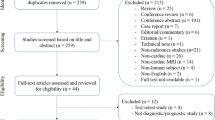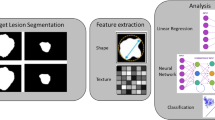Abstract
Objective
Quantification in medical imaging is one of the main goals in research and clinical practice since it allows immediate understanding, objective communication, and comparison. Our aim was to summarize relevant investigations on quantification in nuclear medicine studies published in the volume 32 of Annals of Nuclear Medicine.
Methods
In this article, we summarized the data of 14 selected papers from international research groups that were published between January and December 2018. This is a descriptive review with an inherently subjective selection of articles.
Results
We discussed the role of parameters ranging from standardized uptake value to ratios, to flow within a region of interest, to volumetric parameters and to texture indices in different clinical scenarios in oncology, cardiology, and neurology.
Conclusions
In all the medical disciplines in which nuclear medicine examinations play a role, quantification is essential both in research and in clinical practice. Standardization and high-quality protocols are crucial for the success and reliability of imaging biomarkers.




Similar content being viewed by others
References
Farolfi A, Ghedini P, Fanti S. Highlights from 2017: impactful topics published in the annals of nuclear medicine. Eur J Nucl Med Mol Imaging. 2019;46:217–23.
Jadvar H. Highlights of articles published in annals of nuclear medicine 2016. Eur J Nucl Med Mol Imaging. 2017;44:1928–33.
Inubushi M, Tatsumi M, Yamamoto Y, Kato K, Tsujikawa T, Nishii R. European research trends in nuclear medicine. Ann Nucl Med. 2018;32:579–82.
Inubushi M, Kaneta T, Ishimori T, Imabayashi E, Okizaki A, Oku N. Topics of nuclear medicine research in Europe. Ann Nucl Med. 2017;31:571–4.
Shryock RH. The history of quantification in medical science. Isis. The University of Chicago Press. The History of Science Society. 1961;52:215–37.
Weisz G. Body counts: medical quantification in historical and sociological perspective. In: Weisz G, Jorland G, Opinel A, editors. Body Counts Med Quantif Hist Sociol Perspect Hist Sociol sur la Quantif médicale. Montreal, Kingston, London, Ithaca: McGill-Queen’s University Press; 2005. p. 377–93.
Biomarkers [Internet]. Available from: https://www.ncbi.nlm.nih.gov/mesh/68015415. Accessed 26 Aug 2019.
Aronson JK, Ferner RE. Biomarkers – a general review. Curr Protoc Pharmacol. Hoboken, NJ, USA: John Wiley & Sons, Inc.; 2017;9.23.1–9.23.17.
Sheikh A. Evolution of quantification in clinical nuclear medicine: a brief overview of salient uses and upcoming trends. J Nucl Med Radiat Ther. 2018;09:375.
Sollini M, Cozzi L, Antunovic L, Chiti A, Kirienko M. PET radiomics in NSCLC: state of the art and a proposal for harmonization of methodology. Sci Rep. 2017;7:358.
Abdel Gawad H, Khalil MM, W. Shafaa M, Al Ramlawy S. Development of anatomically and lesion contrast-guided partial volume correction: new 3D formalisms and validation in phantom and clinical studies. Ann Nucl Med. 2019;33:481–94.
Ringheim A, Campos Neto G de C, Martins KM, Vitor T, da Cunha ML, Baroni RH. Reproducibility of standardized uptake values of same-day randomized 68Ga-PSMA-11 PET/CT and PET/MR scans in recurrent prostate cancer patients. Ann Nucl Med. 2018;32:523–31.
Annunziata S, Cuccaro A, Tisi MC, Hohaus S, Rufini V. FDG-PET/CT at the end of immuno-chemotherapy in follicular lymphoma: the prognostic role of the ratio between target lesion and liver SUVmax (rPET). Ann Nucl Med. 2018;32:372–7.
Albano D, Bertoli M, Battistotti M, Rodella C, Statuto M, Giubbini R, et al. Prognostic role of pretreatment 18F-FDG PET/CT in primary brain lymphoma. Ann Nucl Med. 2018;32:532–41.
Anwar H, Vogl TJ, Abougabal MA, Grünwald F, Kleine P, Elrefaie S, et al. The value of different 18 F-FDG PET/CT baseline parameters in risk stratification of stage I surgical NSCLC patients. Ann Nucl Med. 2018;32:687–94.
Beshr R, Isohashi K, Watabe T, Naka S, Horitsugi G, Romanov V, et al. Preliminary feasibility study on differential diagnosis between radiation-induced cerebral necrosis and recurrent brain tumor by means of [ 18 F]fluoro-borono-phenylalanine PET/CT. Ann Nucl Med. 2018;32:702–8.
Yoo J, Kim BS, Yoon HJ. Predictive value of primary tumor parameters using 18 F-FDG PET/CT for occult lymph node metastasis in breast cancer with clinically negative axillary lymph node. Ann Nucl Med. 2018;32:642–8.
Molina-García D, García-Vicente AM, Pérez-Beteta J, Amo-Salas M, Martínez-González A, Tello-Galán MJ, et al. Intratumoral heterogeneity in 18F-FDG PET/CT by textural analysis in breast cancer as a predictive and prognostic subrogate. Ann Nucl Med. 2018;32:379–88.
Parvez A, Tau N, Hussey D, Maganti M, Metser U. 18F-FDG PET/CT metabolic tumor parameters and radiomics features in aggressive non-Hodgkin’s lymphoma as predictors of treatment outcome and survival. Ann Nucl Med. 2018;32:410–6.
Komek H, Can C, Yilmaz U, Altindag S. Prognostic value of 68 Ga PSMA I&T PET/CT SUV parameters on survival outcome in advanced prostat cancer. Ann Nucl Med. 2018;32:542–52.
Lebasnier A, Legallois D, Bienvenu B, Bergot E, Desmonts C, Zalcman G, et al. Diagnostic value of quantitative assessment of cardiac 18F-fluoro-2-deoxyglucose uptake in suspected cardiac sarcoidosis. Ann Nucl Med. 2018;32:319–27.
Nakajima K, Okuda K, Watanabe S, Matsuo S, Kinuya S, Toth K, et al. Artificial neural network retrained to detect myocardial ischemia using a Japanese multicenter database. Ann Nucl Med. 2018;32:303–10.
Habert MO, Bertin H, Labit M, Diallo M, Marie S, Martineau K, et al. Evaluation of amyloid status in a cohort of elderly individuals with memory complaints: validation of the method of quantification and determination of positivity thresholds. Ann Nucl Med. 2018;32:75–86.
Iwabuchi Y, Nakahara T, Kameyama M, Yamada Y, Hashimoto M, Ogata Y, et al. Quantitative evaluation of the tracer distribution in dopamine transporter SPECT for objective interpretation. Ann Nucl Med. 2018;32:363–71.
Lucignani G, Paganelli G, Bombardieri E. The use of standardized uptake values for assessing FDG uptake with PET in oncology: a clinical perspective. Nucl Med Commun. 2004;25:651–6.
Sollini M, Berchiolli R, Delgado Bolton RC, Rossi A, Kirienko M, Boni R, et al. The “3M” approach to cardiovascular infections: multimodality, multitracers, and multidisciplinary. Semin Nucl Med. 2018;48:199–224.
Hoffman EJ, Huang SC, Phelps ME. Quantitation in positron emission computed tomography: 1. Effect of object size. J Comput Assist Tomogr. 1979;3:299–308.
Huang SC, Hoffman EJ, Phelps ME, Kuh DE. Quantitation in positron emission computed tomography: 2. Effects of inaccurate attenuation correction. J Comput Assist Tomogr. 1979;3:804–14.
Hickeson M, Yun M, Matthies A, Zhuang H, Adam LE, Lacorte L, et al. Use of a corrected standardized uptake value based on the lesion size on CT permits accurate characterization of lung nodules on FDG-PET. Eur J Nucl Med. 2002;29:1639–47.
van den Hoff J, Oehme L, Schramm G, Maus J, Lougovski A, Petr J, et al. The PET-derived tumor-to-blood standard uptake ratio (SUR) is superior to tumor SUV as a surrogate parameter of the metabolic rate of FDG. EJNMMI Res. 2013;3:77.
Hofheinz F, van den HJ, Steffen IG, Lougovski A, Ego K, Amthauer H, et al. Comparative evaluation of SUV, tumor-to-blood standard uptake ratio (SUR), and dual time point measurements for assessment of the metabolic uptake rate in FDG PET. EJNMMI Res. 2016;6:53.
van den Hoff J, Lougovski A, Schramm G, Maus J, Oehme L, Petr J, et al. Correction of scan time dependence of standard uptake values in oncological PET. EJNMMI Res. 2014;4:18.
Hofheinz F, Bütof R, Apostolova I, Zöphel K, Steffen IG, Amthauer H, et al. An investigation of the relation between tumor-to-liver ratio (TLR) and tumor-to-blood standard uptake ratio (SUR) in oncological FDG PET. EJNMMI Res. 2016;6:19.
Kunikowska J, Matyskiel R, Toutounchi S, Grabowska-Derlatka L, Koperski Ł, Królicki L. What parameters from 18F-FDG PET/CT are useful in evaluation of adrenal lesions? Eur J Nucl Med Mol Imaging. 2014;41:2273–80.
Bahce I, Vos CG, Dickhoff C, Hartemink KJ, Dahele M, Smit EF, et al. Metabolic activity measured by FDG PET predicts pathological response in locally advanced superior sulcus NSCLC. Lung Cancer. 2014;85:205–12.
Tournoy KG, Maddens S, Gosselin R, Van Maele G, van Meerbeeck JP, Kelles A. Integrated FDG-PET/CT does not make invasive staging of the intrathoracic lymph nodes in non-small cell lung cancer redundant: a prospective study. Thorax. 2007;62:696–701.
Annunziata S, Cuccaro A, Calcagni ML, Hohaus S, Giordano A, Rufini V. Interim FDG-PET/CT in Hodgkin lymphoma: the prognostic role of the ratio between target lesion and liver SUVmax (rPET). Ann Nucl Med. 2016;30:588–92.
Ichise M, Meyer JH, Yonekura Y. An introduction to PET and SPECT neuroreceptor quantification models. J Nucl Med. 2001;42:755–63.
Osborn EA, Jaffer FA. The advancing clinical impact of molecular imaging in CVD. JACC Cardiovasc Imaging. 2013;6:1327–41.
Patlak CS, Blasberg RG, Fenstermacher JD. Graphical evaluation of blood-to-brain transfer constants from multiple-time uptake data. J Cereb Blood Flow Metab. 1983;3:1–7.
Slart RHJA, Glaudemans AWJM, Lancellotti P, Hyafil F, Blankstein R, Schwartz RG, et al. A joint procedural position statement on imaging in cardiac sarcoidosis: from the Cardiovascular and Inflammation & Infection Committees of the European Association of Nuclear Medicine, the European Association of Cardiovascular Imaging, and the American Society of Nuclear Cardiology. Eur Heart J Cardiovasc Imaging. 2017;18:1073–89.
Sollini M, Cozzi L, Chiti A, Kirienko M. Texture analysis and machine learning to characterize suspected thyroid nodules and differentiated thyroid cancer: where do we stand? Eur J Radiol. 2018;99:1–8.
Sollini M, Antunovic L, Chiti A, Kirienko M. Towards clinical application of image mining: a systematic review on artificial intelligence and radiomics. Eur J Nucl Med Mol Imaging. 2019. https://doi.org/10.1007/s00259-019-04372-x.
Sullivan DC, Obuchowski NA, Kessler LG, Raunig DL, Gatsonis C, Huang EP, et al. Metrology standards for quantitative imaging biomarkers 1. Radiology. 2015;277:813–25.
Zwanenburg A, Leger S, Vallières M, Löck S. Initiative for the IBS. Image biomarker standardisation initiative. 2016.
Reyes DK, Pienta KJ. The biology and treatment of oligometastatic cancer. Oncotarget. 2015;6:8491–524.
Kaalep A, Sera T, Oyen W, Krause BJ, Chiti A, Liu Y, et al. EANM/EARL FDG-PET/CT accreditation – summary results from the first 200 accredited imaging systems. Eur J Nucl Med Mol Imaging. 2018;45:412–22.
Fogel AL, Kvedar JC. Artificial intelligence powers digital medicine. NPJ Digit Med. 2018;1:5.
Stupple A, Singerman D, Celi LA. The reproducibility crisis in the age of digital medicine. NPJ Digit Med. 2019;2:2.
Van de Ven AH, Schomaker MS. Commentary: the rhetoric of evidence-based medicine. Health Care Manag Rev. 2002;27:89–91.
Acknowledgements
MK PhD scholarship was funded by the AIRC grant IG-2016-18585. We thank all colleagues from the Nuclear Medicine Department of Humanitas Clinical and Research Center for their collaboration and Prof. Carlo Stella for cooperation with the Hematology Department.
Author information
Authors and Affiliations
Contributions
MS and MK conceptualized the study, MK performed data selection, MS and FB drafted the paper, FB commented on the paper, and MK reviewed the paper; all the authors approved the manuscript.
Corresponding author
Ethics declarations
Ethical statement
In view of the nature of the present article (i.e., review), ethical approval was considered unnecessary. Figures are based on anonymized images, taken from existing research database, published with patient consent.
Conflict of interest
The authors declare that they have no conflict of interest.
Additional information
Publisher’s note
Springer Nature remains neutral with regard to jurisdictional claims in published maps and institutional affiliations.
This article is part of the Topical Collection on Advanced Image Analyses (Radiomics and Artificial Intelligence)
Rights and permissions
About this article
Cite this article
Sollini, M., Bandera, F. & Kirienko, M. Quantitative imaging biomarkers in nuclear medicine: from SUV to image mining studies. Highlights from annals of nuclear medicine 2018. Eur J Nucl Med Mol Imaging 46, 2737–2745 (2019). https://doi.org/10.1007/s00259-019-04531-0
Received:
Accepted:
Published:
Issue Date:
DOI: https://doi.org/10.1007/s00259-019-04531-0




